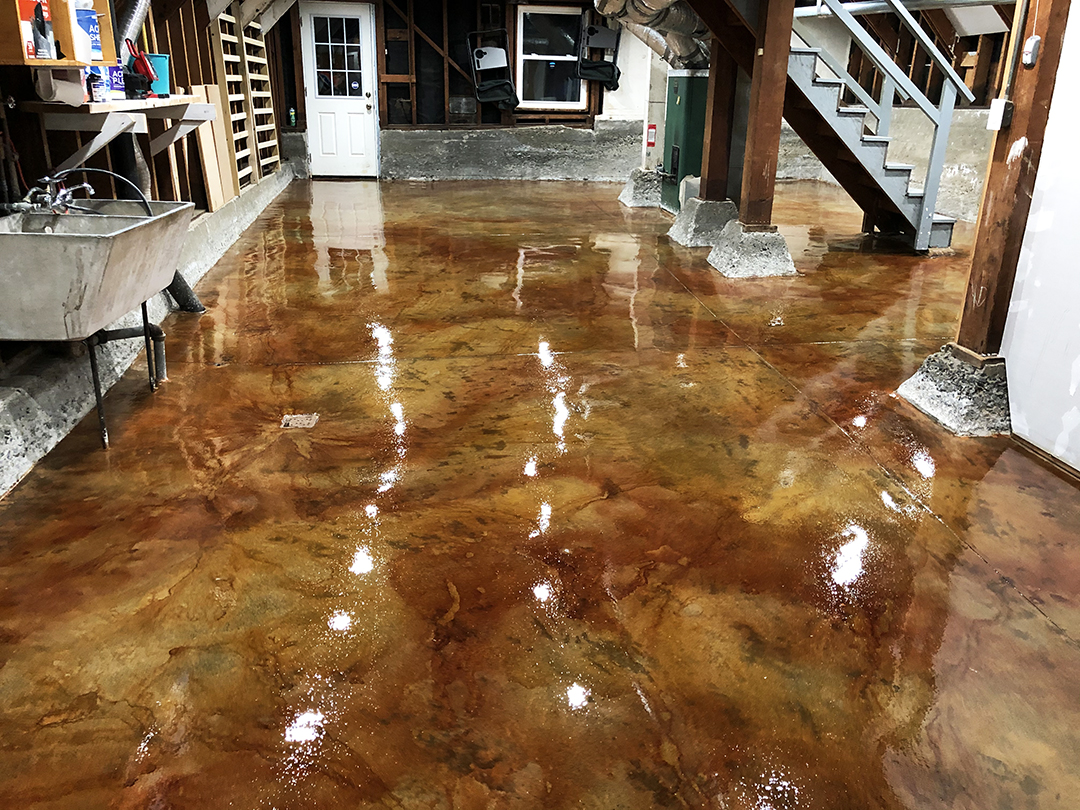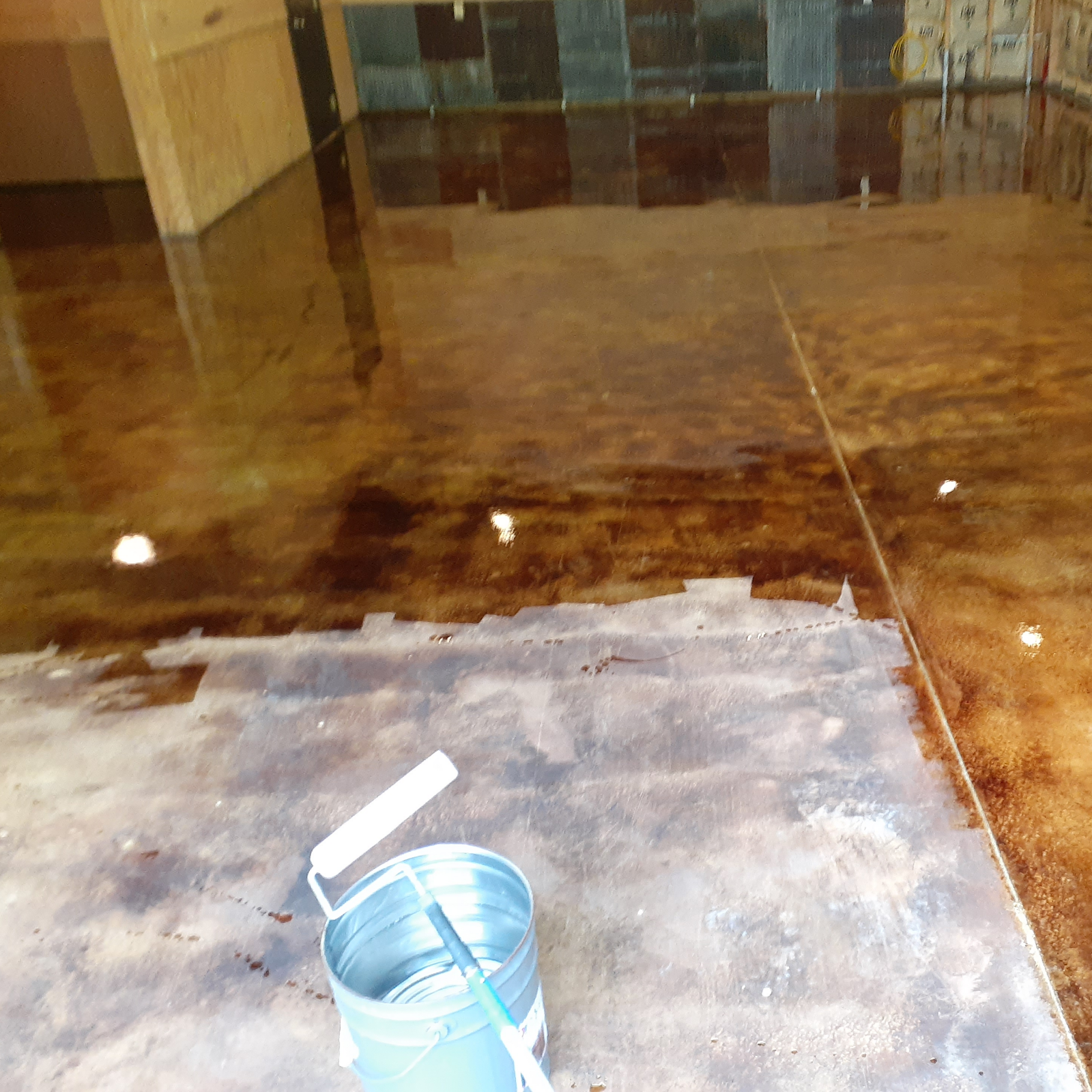Understanding the Variety of Providers Offered in Floor Covering: Highlighting Stained Concrete Techniques
Stained concrete has actually arised as an engaging floor covering alternative for various areas. Its convenience hinges on the selection in between acid and water-based stains, each supplying unique aesthetics. Appropriate prep work and recurring maintenance are important to ensure its resilience and look. As the need for innovative floor covering solutions expands, recognizing the nuances of tarnished concrete strategies might open brand-new opportunities for both household and business atmospheres. What one-of-a-kind benefits might this flooring choice bring to a job?
The Essentials of Stained Concrete
Stained concrete offers as a flexible floor covering option that combines sturdiness with aesthetic appeal. This flooring method includes applying a specifically developed stain to the concrete surface, which passes through and changes the shade of the material. The procedure not just boosts the appearances of concrete but likewise provides the advantage of safeguarding it from deterioration. Stained concrete can attain a vast array of appearances, from earthy tones to lively hues, making it ideal for various style styles.
Correct preparation of the concrete surface is essential for perfect outcomes. This may consist of cleansing, grinding, or engraving to assure the stain adheres efficiently. Additionally, the application process usually includes making use of devices such as sprayers or brushes to attain uniform coverage. After staining, a sealer is typically put on enhance resilience and keep the vibrancy of the shade. Ultimately, stained concrete gives an attractive and resilient flooring remedy for property and industrial spaces alike.
Types of Stains: Acid vs. Water-Based

In comparison, water-based spots supply a larger array of shades and are simpler to use. They do not respond chemically with concrete yet instead give a surface tint - austin stained concrete service. Water-based stains are reduced in unpredictable organic compounds (VOCs), making them more eco-friendly and appropriate for indoor projects. While they might not supply the very same depth of color as acid spots, their flexibility and simplicity of usage make them appealing for different applications. Inevitably, the choice relies on the task's demands, preferred looks, and place
Techniques for Staining Concrete
The strategies for tarnishing concrete vary substantially between acid and water-based approaches. Acid staining involves a chemical reaction that develops special, variegated shades, while water-based stains provide a more comprehensive scheme and easier application. Recognizing these procedures is vital for achieving the preferred visual in concrete flooring.
Acid Staining Refine
Acid staining offers a vibrant method to enhance the aesthetic charm of concrete surfaces. This process entails applying a combination of water, hydrochloric acid, and pigments to the concrete, which responds chemically to create dynamic, transparent colors. Initially, the concrete surface needs to be thoroughly cleaned and prepped to guarantee ideal attachment. When applied, the acid stain penetrates the concrete, developing unique marbled effects as it responds with the lime in the concrete. After the preferred color develops, the surface is neutralized and washed to halt the reaction. A sealer is applied to safeguard the surface and enhance durability. Acid staining not just transforms the appearance of concrete but additionally provides a lasting service for ornamental floor covering.
Water-Based Staining Benefits
Exactly how can water-based staining elevate the visual and functional top qualities of concrete surface areas? Water-based spots offer a functional solution for improving concrete, supplying vivid color alternatives while assuring ecological safety and security. Unlike acid discolorations, water-based alternatives pass through the surface area, enabling for even color distribution and a series of surfaces, from matte to glossy. In addition, they are reduced in volatile organic compounds (VOCs), making them much less harmful to indoor air top quality. Their fast drying time promotes much faster project conclusion, while their resistance to fading makes sure lasting charm. Water-based spots can additionally improve the concrete's longevity and resistance to spots, making them a perfect choice for both residential and industrial applications. Eventually, they provide a lasting, attractive remedy for different concrete surfaces.
Layout Possibilities With Stained Concrete
Stained concrete offers a range of style opportunities that can enhance any space. Techniques such as click to read color variant, numerous surface ending up options, and customized style patterns enable unique and customized floor covering solutions. These aspects not just boost aesthetics but additionally add to the total performance of the concrete surface.
Shade Variation Strategies
While exploring the design possibilities of stained concrete, shade variation techniques play an essential duty in enhancing both aesthetic appeal and performance. These methods enable the production of distinct patterns and impacts that can transform a basic concrete surface area into an aesthetically striking component of a room. Alternatives such as acid staining, which reacts chemically with the concrete, generate rich, translucent shades that imitate natural stone. Water-based stains offer a wider color combination and enable more control in layout. Layering various spots can create deepness and measurement, giving a customized appearance. By integrating color variant methods, developers can attain varied designs, from rustic to modern, ensuring that discolored concrete fits flawlessly right into any style system.
Surface Area Finishing Options
The exploration of color variation techniques sets the phase for thinking about surface area finishing choices, which significantly impact the total look and capability of stained concrete. Numerous finishes can improve the visual charm and sturdiness of the surface. Typical choices consist of matte, satin, and shiny coatings, each supplying an unique visual impact. Matte finishes supply a refined, underrated beauty, while satin surfaces strike a balance in between sheen and functionality, making them preferred for property and business rooms. Shiny coatings, on the other hand, develop a high-shine look, enhancing color vibrancy and light representation. In addition, surface area therapies such as polishing or securing further improve longevity, making these finishing alternatives essential factors to consider in designing useful and visually enticing discolored concrete floorings.
Custom Layout Patterns
How can custom design patterns boost the charm of discolored concrete? By incorporating one-of-a-kind layouts, discolored concrete can change normal floor covering into a striking visual declaration. Personalized patterns, such as geometric forms, elaborate themes, or organic designs, permit for customization, making areas feel customized and inviting. Customers can pick from a selection of methods, including saw cuts, patterns, or overlays, to check this site out accomplish preferred effects. In addition, integrating multiple shades with different stain techniques improves the depth and dimension of the patterns. These design opportunities not just boost visual allure however also raise the value of domestic or business areas. Ultimately, personalized style patterns provide a possibility for imagination, setting tarnished concrete besides conventional floor covering alternatives.
Preparing Your Concrete Surface Area
Appropriate prep work of the concrete surface is essential for achieving an effective discolored surface. This procedure starts with comprehensive cleaning to remove dust, oil, and any type of various other pollutants. A stress washer or a flooring scrubber can effectively eliminate these materials, making certain a fresh start for staining. After cleaning, it is vital to repair any splits or imperfections in the concrete. This can be achieved utilizing a concrete patching substance, which should be enabled to treat totally prior to proceeding.
When the surface is tidy and fixed, grinding or sanding may be needed to create a smooth, even appearance. This step improves the This Site concrete's capacity to soak up the stain consistently. A concrete etcher can be applied to open up the pores of the surface, enabling for much better bond of the stain. By complying with these prep work steps, the resulting discolored concrete will display a much more dynamic and long-term coating
Upkeep and Treatment for Stained Concrete
Preserving discolored concrete is essential for preserving its appearance and long life after the initial preparation and application of stain. Regular cleansing is important; sweeping or vacuuming to get rid of dust and particles prevents scrapes and dullness. For deeper cleaning, a moderate pH-neutral cleaning agent blended with water can be used, adhered to by comprehensive rinsing to stay clear of residue accumulation.
Sealing stained concrete is another key upkeep step, as it safeguards the surface from discolorations and wetness. Depending upon the sealant kind, reapplication may be necessary each to three years. Additionally, staying clear of extreme chemicals and rough tools helps keep the stability of the stain.
For outside tarnished concrete, it is advisable to clear snow or ice promptly to avoid damage from freeze-thaw cycles. Generally, regular care warranties that discolored concrete retains its lively color and architectural stability with time, making it a durable flooring selection.

Price Considerations for Stained Concrete Flooring
When evaluating the price of stained concrete flooring, potential homeowners usually wonder about the various factors that influence pricing. Key considerations include the dimension of the location to be covered, the complexity of the design, and the kind of stain used. Basic staining techniques have a tendency to be more budget friendly, while intricate patterns or numerous shades can considerably boost costs.

Geographic location is another aspect, as rates can differ widely from one region to another. Recurring upkeep prices must be factored in, as sealers and safety layers may be needed over time to maintain the visual and resilience of the stained concrete.
Frequently Asked Concerns
Can Stained Concrete Be Applied Over Existing Floor Covering?
The inquiry of whether tarnished concrete can be used over existing floor covering is usually asked. Typically, it is feasible, supplied the underlying surface is tidy, steady, and suitable for proper attachment of the discolored concrete.
The length of time Does the Staining Refine Take?
The staining process commonly takes a few hours to a complete day, depending on the dimension of the location and the complexity of the layout. Curing might call for extra time prior to the surface area is completely useful.
Is Stained Concrete Suitable for Outdoor Use?
Stained concrete is without a doubt suitable for outside usage, as it endures different weather conditions. Its longevity and aesthetic charm make it a preferred selection for patios, sidewalks, and driveways, enhancing both capability and aesthetic rate of interest.
Can I Adjustment the Color of Stained Concrete Later On?
The capacity to change the color of stained concrete later depends upon numerous elements, including the original stain type and surface preparation. Consulting a professional can offer support on prospective choices and results for shade modification.
Are There Eco-Friendly Options for Stained Concrete?
The query regarding green alternatives for tarnished concrete discloses an expanding rate of interest in sustainable building practices. Many companies now offer low-VOC stains and environmentally pleasant sealants, making sure visual charm while lessening environmental effect.